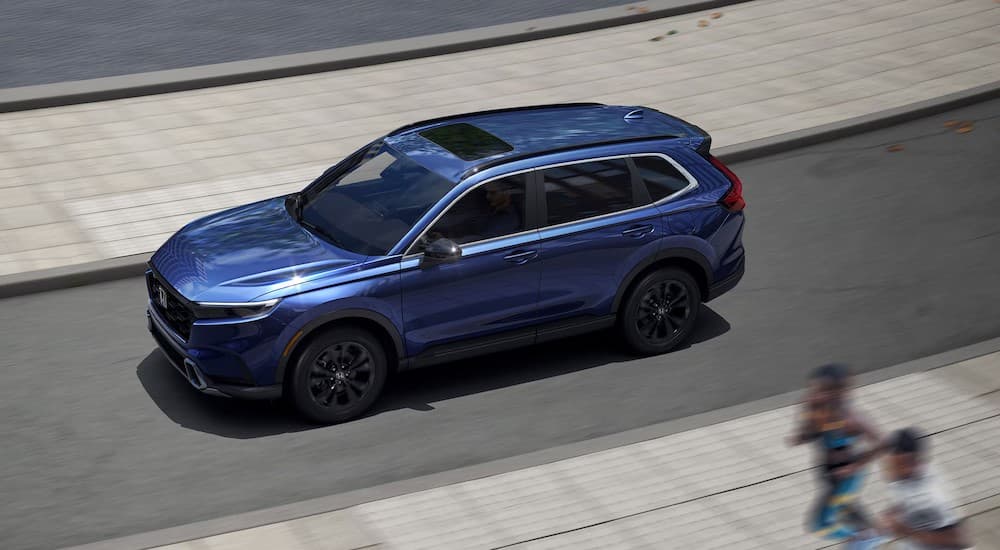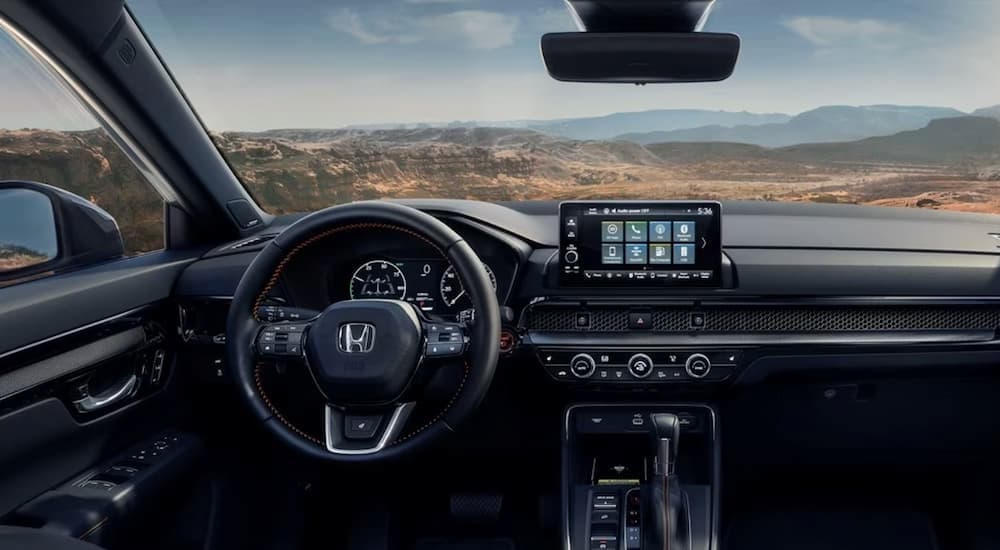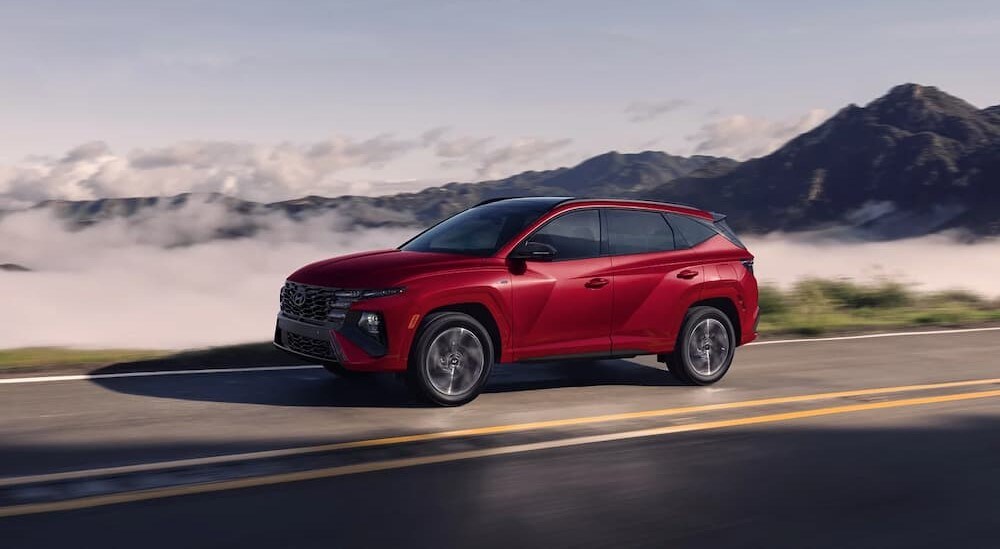 In the battle for buyers, no segment is more competitive than the compact SUV category, and affordability, reliability, and style are top demands. The compact SUV category offers dozens of options, but hybrid models are beginning to climb their way to the top. For 2025, buyers are clamoring to purchase hybrid vehicles to save big on fuel costs. Recently, searches have ticked up for finding models like the Honda CR-V Hybrid for sale; the 2025 CR-V Hybrid is an incredibly fuel-efficient model, and one Car and Driver rated a perfect 10/10 for its “exceptionally refined hybrid powertrain.”[a]
In the battle for buyers, no segment is more competitive than the compact SUV category, and affordability, reliability, and style are top demands. The compact SUV category offers dozens of options, but hybrid models are beginning to climb their way to the top. For 2025, buyers are clamoring to purchase hybrid vehicles to save big on fuel costs. Recently, searches have ticked up for finding models like the Honda CR-V Hybrid for sale; the 2025 CR-V Hybrid is an incredibly fuel-efficient model, and one Car and Driver rated a perfect 10/10 for its “exceptionally refined hybrid powertrain.”[a]
Still, other major automotive brands seek to unseat Honda in the hybrid compact SUV category. Korean manufacturer Hyundai offers the 2025 Hyundai Tucson Hybrid as a CR-V Hybrid alternative. With a slightly lower starting price than the CR-V Hybrid, the Tucson Hybrid starts off strong; however, its lower rating from Car and Driver—an 8.5/10—is the first sign that the Tucson might not stack up. In fairness, the Honda brand is tough to beat in any category. Honda is dedicated to building some extremely reliable vehicles, and the CR-V is certainly among them.
The best way to determine which hybrid SUV ticks all the boxes is to compare them side-by-side, feature-by-feature. Practical metrics such as fuel economy ratings and cargo capacity tell one part of the story, while subjective considerations like curb appeal and third-party reviews round out the comparison with important, informed opinions. Of course, no two buyers are alike, but in the battle between the 2025 Honda CR-V Hybrid and the 2025 Hyundai Tucson Hybrid, the facts reveal a clear winner.
Why a Hybrid Makes Sense
New vehicle buyers want it all—performance, environmental consciousness, and real savings at the pump. Hybrids are great stepping stones for drivers looking to eventually purchase an electric vehicle, and hybrid SUVs like the CR-V Hybrid deliver a compelling value proposition, combining the utility of an SUV with a fuel-efficient engine that doesn’t rely on electricity for power. Because hybrids run on a combination of a combustion engine and electric power, you’ll use less fuel over time.
The CR-V Hybrid shifts from gas to electricity automatically to maximize fuel efficiency, determining which power source will provide optimal efficiency in any given driving situation. For example, the vehicle shifts to all-electric power during low-speed driving or when idling. Upon acceleration, the system draws power from the gas engine to increase performance. The system also operates both systems simultaneously when more power is needed, such as when you accelerate to pass or travel up a steep incline.
The Honda CR-V’s regenerative braking system captures energy expended during deceleration, storing it and recharging the electric motor’s battery, which extends the electric range. This process happens automatically as you drive, allowing for constant recharging and a more efficient overall driving experience. Hybrid technology also reduces your environmental footprint by producing fewer emissions, which is good news for drivers looking to reduce their carbon footprint.
 Fuel Economy and Performance
Fuel Economy and Performance
When buyers lean toward a hybrid, they’re seeking a fuel-efficient vehicle that will keep ownership costs low, but for many buyers, affordability is only the beginning. Performance is also important. The 2025 CR-V Hybrid delivers big, with a standard 2.0-liter four-cylinder engine boosted by two electric motors, which combine to deliver 204 horsepower and an EPA-estimated 43 MPG in the city.[b] Buyers can choose between the ultra-fuel-efficient two-wheel drive or all-wheel drive for added traction. Car and Driver clocked the CR-V Hybrid’s zero-to-sixty time at 7.9 seconds.
The 2025 Tucson Hybrid comes out ahead of the CR-V Hybrid with 27 additional horsepower via a turbocharged 1.6-liter four-cylinder and a single electric motor; however, fuel economy ratings take a hit, landing far below the most efficient CR-V Hybrid models at 38 MPG in the city. Given the minimal performance difference, buyers should consider whether the Tuscson’s slightly higher horsepower is worth sacrificing the 5 MPG fuel economy advantage you’ll get with the 2025 Honda CR-V Hybrid. Most buyers would likely say no.
Looking at it a different way, if you drive 1,000 miles in stop-and-go traffic, you’ll need approximately 26.3 gallons of gas to power the Tucson Hybrid vs 23.3 gallons for the CR-V Hybrid. Saving three gallons of gas may not seem like a lot, but at today’s gas prices, it’s enough to pay for that coffee shop latte. Over time, the differences in fuel economy add up, not to mention the associated environmental impact and the hassle of having to stop for gas more often. For most hybrid vehicle buyers, it’s all about maximum efficiency. If you agree, the clear choice is the CR-V Hybrid.
Technology and In-Vehicle Comfort
Honda puts the focus on ergonomics in the newest CR-V Hybrid. With easy-to-reach controls and a nicely sized infotainment touchscreen that doesn’t overwhelm the dash, drivers can settle in and focus on the road ahead. The cavernous cargo area offers up to 76.5 cu.ft. of space with the rear seats folded flat, and the split-folding rear seats make it easy to stow oversized gear like skis and snowboards. The Tucson Hybrid’s cargo volume is a full two cu.ft. smaller than its competitor at 74.5 cu.ft. with the rear seats folded down.
High-end Tucson Hybrid trims receive a Bose audio system with eight speakers. However, when you purchase the top-of-the-line Honda CR-V Sport Touring Hybrid, you get a 12-speaker Bose premium audio system with a subwoofer. The system cranks out concert-grade sound, which commuters will love for streaming their favorite playlists or podcast episodes. Honda also looks after your comfort with a standard 10-way power driver's seat, while Hyundai falls behind slightly with a less customizable eight-way driver's seat.

Is a Hybrid Right for You?
Buyers considering a hybrid SUV should consider several factors, including individual driving needs and lifestyle. For drivers who spend a lot of time driving locally or sitting in stop-and-go traffic, vehicles like the CR-V Hybrid make sense. Savvy commuters regularly choose hybrid vehicles for their lower fuel costs. Fewer trips to the gas station mean you’ll put more dollars in your pocket over time, and those frequent spikes in gas prices will have less impact.
Many hybrid buyers choose vehicles like the CR-V Hybrid because they’re not quite ready to transition to a fully electric vehicle. Hybrids embrace the advantages of electrification without requiring the massive lifestyle shift that comes with a battery-electric vehicle. The fuel savings are still substantial, but drivers won’t have to worry about finding a charging station when the battery runs low. Best of all, hybrid vehicles substantially reduce carbon emissions.
Though hybrids are typically more expensive upfront than their traditional gasoline-only counterparts, the difference is shrinking every year, and buyers usually realize long-term savings on gas costs. Some hybrids are even eligible for state or federal tax incentives, many of which are substantial enough to offset the additional upfront cost of your hybrid vehicle. If you're interested in seeing if a hybrid is right for you, the 2025 Honda CR-V Hybrid is a great place to start and we can't wait to show you all of its benefits in person!